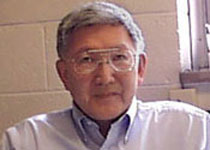
Dr. Chung is interested in the biosynthesis and assembly of the extracellular matrix glycoproteins laminin and entactin, the roles they play in embryogenesis and metastasis, and their interaction with cell surfaces. These problems are approached by using cell cultures, recombinant DNA techniques, immunology, conventional biochemical methods,and gene inactivation in mice.
It is now firmly established that cell-extracellular matrix interactions are critical in regulating gene expression and morphogenesis. Both the architecture of the matrix and the cell surface receptors are important in these processes. An area of concentration of research in Dr. Chung's laboratory is the analysis of the assembly of laminin and the laminin-entactin complex. Several cell lines which express combinations of the genes which code for the three chains of laminin and entactin are being studied. The biological consequences of introducing the missing gene and mutant forms into these cells, as well as the suppression of expression of individual genes are being explored. An example of this approach is the introduction of the entactin and laminin genes and deletion mutants into human choriocarcinoma and other cells, which do not synthesize these molecules. The assembly and properties of the resulting matrix are then examined.
Entactin is organized into distinct domains that bind calcium, support cell adhesion, promote neutrophil chemotaxis and phagocytosis and interact with laminin, perlecan, fibronectin, and type IV collagen. It is believed that entactin is important in the assembly of the extracellular matrix and can serve as a bridge between the components ofthe matrix. In embryogenesis cell-extracellular matrix contacts are continually being made and broken during cell migration and organogenesis. These contacts depend, at any particular time, on the specific plasma membrane receptors and the mosaic of exposed ligands in the matrix that are present. Another area of active research in Dr. Chung's laboratory is, therefore, exploration of the temporal pattern ofexpression of entactin, other matrix components, and their receptors during mouse and zebrafish embryogenesis. Experiments are in progress to inactivate the entactin gene in mice by employing embryonic stem cells.The homozygous entactin-null mutations promise to yield valuable insight into the in vivo biological functions of entactin.
The transduction of signals between the extracellular and intracellular compartments is effected by transmembrane receptors which include the integrin family of proteins. Entactin has been shown to serve as a substrate for the attachment of certain cells. The isolation and characterization of plasma membrane receptors for entactin represent a third area of research. Two distinct integrin receptors have been shown to bind to separate sites on entactin. A different physiological response is elicited in neutrophils depending on which ligand is engaged by its cognate receptor. The mechanisms by which the cell discriminates between the two signals induced by ligand binding is of considerable interest to Dr. Chung's laboratory.
- Albert Chung, Professor Emeritus
